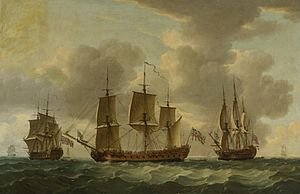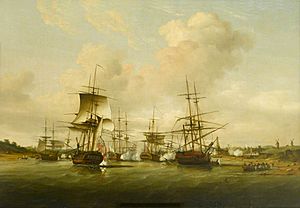HMS Pallas (1757) facts for kids

Pallas in three positions, by John Cleveley the Elder, 1769
|
|
Quick facts for kids History |
|
|---|---|
| Name | HMS Pallas |
| Ordered | 13 July 1756 |
| Builder | William Wells, Deptford |
| Laid down | July 1756 |
| Launched | 30 August 1757 |
| Completed | 8 October 1757 at Deptford Dockyard |
| Commissioned | August 1757 |
| Fate | Burnt to avoid capture, 24 February 1783 |
| General characteristics | |
| Class and type | Venus-class fifth-rate frigate |
| Tons burthen | 728 73⁄94 bm |
| Length |
|
| Beam | 35 ft 10.75 in (10.9411 m) |
| Depth of hold | 12 ft 4.5 in (3.772 m) |
| Sail plan | Full-rigged ship |
| Complement | 240 officers and men |
| Armament |
|
HMS Pallas was a fast and powerful warship of the Royal Navy. She was one of three Venus-class class frigates, meaning she had 36 guns. Launched in 1757, Pallas served in many important naval operations.
She helped blockade the French coast and fought in battles like the Raid on Cherbourg. Later, she sailed in the Mediterranean Sea and off the coast of Africa, protecting British settlements. In 1778, she joined the Newfoundland Station and took part in an attack on Saint Pierre and Miquelon. Pallas also helped stop a French invasion of the Channel Islands in 1779. Sadly, in 1783, she started leaking badly and had to be burned to prevent her capture.
Contents
Building a Warship: The Pallas Story
The Venus-class frigates, like Pallas, were designed by Sir Thomas Slade. He was a very important naval architect. These ships were an exciting new experiment in warship design. They were built to be fast and medium-sized. This allowed them to catch smaller enemy ships and fight larger ones.
One clever idea Slade used was inspired by French ship designs. He removed the gunports from the lower deck. This meant all the cannons were on the upper deck. This allowed the ship to carry heavier guns without becoming too big. The lower deck was then used for extra supplies. This helped Pallas stay at sea for longer missions without needing to resupply.
What Guns Did Pallas Carry?
Pallas had 36 guns in total. Her main weapons were 26 large 12-pounder cannons. These were placed along her upper deck. These cannons were specially made with shorter barrels. This was because the ship's design was narrower than other warships. Each of these cannons weighed about 28.5 long tons.
She also had ten smaller 6-pounder guns. Eight of these were on the quarterdeck, and two were on the forecastle. Each 6-pounder gun weighed about 16.5 long tons. When all these guns fired together, they could deliver a powerful broadside of 189 pounds of cannonballs. Pallas also carried twelve small 1/2-pound swivel guns. These were fixed in place and used against enemy crews.
Pallas at Sea: Her Adventures

Pallas began her service in August 1757. Her first captain was Archibald Clevland. She joined Sir Edward Hawke's fleet, which was blocking the French coast. On November 3, she captured a French privateer ship called Le Hasard. In August 1758, she was the flagship for Commodore Richard Howe during the Raid on Cherbourg. She also helped with operations at Saint Cas.
Around June 1759, Captain Michael Clements took command. He led Pallas in the Battle of Bishops Court on February 28, 1760. In this battle, Pallas and two other British frigates captured three French frigates.
Mediterranean and African Missions
After the battle, Pallas sailed to the Mediterranean Sea on June 19. She tried to slow down a large French warship called Diadème. This was so more powerful British ships could catch it. She continued to serve in the Mediterranean through 1761 and 1762. On June 23, 1762, she captured another French privateer, La Revanche.
In July, two Spanish ships attacked Pallas in Cadiz Bay. Pallas was winning, but a Spanish warship arrived and forced her to leave. In January 1764, Pallas was taken out of service. She was repaired at Portsmouth Dockyard between February and December 1770.
Captain John Laforey recommissioned her in October 1770. She was involved in the Falklands Crisis. After the crisis ended, Captain George Watson took over in 1771. He sailed Pallas back to the Mediterranean.
Captain James Almes became captain in 1773. Pallas was refitted again in May. Then, Captain William Cornwallis took command in September 1774. He sailed her to the coast of Africa in December. There, she protected British settlements and trade in places like Senegal and Gambia.
Captain Rowland Cotton took command in 1777. Pallas focused on protecting merchant ships. She returned home in early 1778. She was refitted again at Portsmouth. Captain Richard King then took over.
Protecting the Channel and Final Voyages
On May 25, Captain King sailed Pallas to Newfoundland. There, she joined an expedition that attacked Saint Pierre and Miquelon on September 14. The next month, Captain Thomas Spry became her commander. He sailed the ship back to England. She had her hull covered in copper at Plymouth Dockyard in 1779. This was a new way to protect ships from worms and make them faster.
After leaving the dockyard, Pallas helped defend the Channel Islands. She played a role in the action of 13 May 1779. In this battle, a large group of British ships, including Pallas, stopped a French invasion force. In June, she sailed to Jamaica. On November 11, 1780, she captured a small Spanish frigate called Diana.
Captain Christopher Parker took command of Pallas in 1782. He sailed her home, then to Halifax. There, she served as a convoy escort, protecting groups of merchant ships.
The End of Pallas
Pallas soon returned to home waters from North America. But in February 1783, while at sea near the Azores islands, the ship began to leak very badly. She was so damaged that she had to be run aground on São Jorge Island on February 12. Twelve days later, on February 24, Pallas was burned to prevent her from falling into enemy hands.



